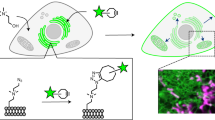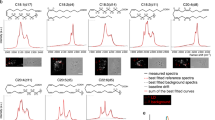Abstract
Microscopy of lipids in living cells is currently hampered by a lack of adequate fluorescent tags. The most frequently used tags, NBD and BODIPY, strongly influence the properties of lipids, yielding analogs with quite different characteristics. Here, we introduce polyene-lipids containing five conjugated double bonds as a new type of lipid tag. Polyene-lipids exhibit a unique structural similarity to natural lipids, which results in minimal effects on the lipid properties. Analyzing membrane phase partitioning, an important biophysical and biological property of lipids, we demonstrated the superiority of polyene-lipids to both NBD- and BODIPY-tagged lipids. Cells readily take up various polyene-lipid precursors and generate the expected end products with no apparent disturbance by the tag. Applying two-photon excitation microscopy, we imaged the distribution of polyene-lipids in living mammalian cells. For the first time, ether lipids, important for the function of the brain, were successfully visualized.
This is a preview of subscription content, access via your institution
Access options
Subscribe to this journal
Receive 12 print issues and online access
$259.00 per year
only $21.58 per issue
Buy this article
- Purchase on Springer Link
- Instant access to full article PDF
Prices may be subject to local taxes which are calculated during checkout






Similar content being viewed by others
References
Simons, K. & Ikonen, E. Functional rafts in cell membranes. Nature 387, 569–572 (1997).
Brown, D.A. & London, E. Structure and origin of ordered lipid domains in biological membranes. J. Membr. Biol. 164, 103–114 (1998).
Magee, T., Pirinen, N., Adler, J., Pagakis, S.N. & Parmryd, I. Lipid rafts: cell surface platforms for T cell signaling. Biol. Res. 35, 127–131 (2002).
Holthuis, J.C., van Meer, G. & Huitema, K. Lipid microdomains, lipid translocation and the organization of intracellular membrane transport (Review). Mol. Membr. Biol. 20, 231–241 (2003).
Maier, O., Oberle, V. & Hoekstra, D. Fluorescent lipid probes: some properties and applications (Review). Chem. Phys. Lipids 116, 3–18 (2002).
Ishitsuka, R., Yamaji-Hasegawa, A., Makino, A., Hirabayashi, Y. & Kobayashi, T. A lipid-specific toxin reveals heterogeneity of sphingomyelin-containing membranes. Biophys. J. 86, 296–307 (2004).
Chattopadhyay, A. Chemistry and biology of N-(7-nitrobenz-2-oxa-1,3-diazol-4-yl)-labeled lipids: fluorescent probes of biological and model membranes. Chem. Phys. Lipids 53, 1–15 (1990).
Pagano, R.E., Martin, O.C., Kang, H.C. & Haugland, R.P. A novel fluorescent ceramide analogue for studying membrane traffic in animal cells: accumulation at the Golgi apparatus results in altered spectral properties of the sphingolipid precursor. J. Cell Biol. 113, 1267–1279 (1991).
Stoffel, W. & Michaelis, G. Chemical syntheses of novel fluorescent-labelled fatty acids, phosphatidylcholines and cholesterol esters. Hoppe-Seyler's Z. Physiol. Chem. 357, 7–19 (1976).
Somerharju, P. Pyrene-labeled lipids as tools in membrane biophysics and cell biology. Chem. Phys. Lipids 116, 57–74 (2002).
Antes, P., Schwarzmann, G. & Sandhoff, K. Distribution and metabolism of fluorescent sphingosines and corresponding ceramides bearing the diphenylhexatrienyl (DPH) fluorophore in cultured human fibroblasts. Eur. J. Cell Biol. 59, 27–36 (1992).
Pagano, R.E. & Sleight, R.G. Defining lipid transport pathways in animal cells. Science 229, 1051–1057 (1985).
Kaiser, R.D. & London, E. Determination of the depth of BODIPY probes in model membranes by parallax analysis of fluorescence quenching. Biochim. Biophys. Acta 1375, 13–22 (1998).
Wang, T.Y. & Silvius, J.R. Different sphingolipids show differential partitioning into sphingolipid/cholesterol-rich domains in lipid bilayers. Biophys. J. 79, 1478–1489 (2000).
Sklar, L.A., Hudson, B.S. & Simoni, R.D. Conjugated polyene fatty acids as membrane probes: preliminary characterization. Proc. Natl. Acad. Sci. USA 72, 1649–1653 (1975).
Lentz, B.R. Use of fluorescent probes to monitor molecular order and motions within liposome bilayers. Chem. Phys. Lipids 64, 99–116 (1993).
Mateo, C.R., Souto, A.A., Amat-Guerri, F. & Acuna, A.U. New fluorescent octadecapentaenoic acids as probes of lipid membranes and protein-lipid interactions. Biophys. J. 71, 2177–2191 (1996).
Quesada, E., Acuna, A.U. & Amat-Guerri, F. New transmembrane polyene bolaamphiphiles as fluorescent probes in lipid bilayers. Angew. Chem. Int. Edn. Engl. 40, 2095–2097 (2001).
Quesada, E., Acuna, A.U. & Amat-Guerri, F. Synthesis of carboxyl-tethered symmetric conjugated polyenes as fluorescent transmembrane probes of lipid bilayers. Eur. J. Org. Chem. 2003, 1308–1318 (2003).
Souto, A.A., Ulises Acuna, A. & Amat-Guerri, F. A general and practical synthesis of linear conjugated pentaenoic acids. Tetrahedr. Lett. 35, 5907–5910 (1994).
London, E. & Feigenson, G.W. Fluorescence quenching in model membranes. 1. Characterization of quenching caused by a spin-labeled phospholipid. Biochemistry 20, 1932–1938 (1981).
Ahmed, S.N., Brown, D.A. & London, E. On the origin of sphingolipid/cholesterol-rich detergent-insoluble cell membranes: physiological concentrations of cholesterol and sphingolipid induce formation of a detergent-insoluble, liquid-ordered lipid phase in model membranes. Biochemistry 36, 10944–10953 (1997).
Brown, D.A. & Rose, J.K. Sorting of GPI-Anchored proteins to glycolipid-enriched membrane subdomains during transport to the apical cell surface. Cell 68, 533–544 (1992).
Roper, K., Corbeil, D. & Huttner, W.B. Retention of prominin in microvilli reveals distinct cholesterol-based lipid micro-domains in the apical plasma membrane. Nat. Cell Biol. 2, 582–592 (2000).
Nagan, N. & Zoeller, R.A. Plasmalogens: biosynthesis and functions. Prog. Lipid Res. 40, 199–229 (2001).
Tanhuanpaa, K. & Somerharju, P. Gamma-cyclodextrins greatly enhance translocation of hydrophobic fluorescent phospholipids from vesicles to cells in culture. Importance of molecular hydrophobicity in phospholipid trafficking studies. J. Biol. Chem. 274, 35359–35366 (1999).
Ekroos, K. et al. Charting molecular composition of phosphatidylcholines by fatty acid scanning and ion trap MS3 fragmentation. J. Lipid Res. 44, 2181–2192 (2003).
Denk, W., Strickler, J.H. & Webb, W.W. Two-photon laser scanning fluorescence microscopy. Science 248, 73–76 (1990).
Campbell, R.E. et al. A monomeric red fluorescent protein. Proc. Natl. Acad. Sci. USA 99, 7877–7882 (2002).
Huang, H., Starodub, O., McIntosh, A., Kier, A.B. & Schroeder, F. Liver fatty acid-binding protein targets fatty acids to the nucleus Real time confocal and multiphoton fluorescence imaging in living cells. J. Biol. Chem. 277, 29139–29151 (2002).
Lipsky, N.G. & Pagano, R.E. A vital stain for the Golgi apparatus. Science 228, 745–747 (1985).
Bielawska, A., Crane, H.M., Liotta, D., Obeid, L.M. & Hannun, Y.A. Selectivity of ceramide-mediated biology. Lack of activity of erythro-dihydroceramide. J. Biol. Chem. 268, 26226–26232 (1993).
Li, L., Tang, X., Taylor, K.G., DuPre, D.B. & Yappert, M.C. Conformational characterization of ceramides by nuclear magnetic resonance spectroscopy. Biophys. J. 82, 2067–2080 (2002).
Mukherjee, S. & Maxfield, F.R. Role of membrane organization and membrane domains in endocytic lipid trafficking. Traffic 1, 203–211 (2000).
Brugger, B., Erben, G., Sandhoff, R., Wieland, F.T. & Lehmann, W.D. Quantitative analysis of biological membrane lipids at the low picomole level by nano-electrospray ionization tandem mass spectrometry. Proc. Natl. Acad. Sci. USA 94, 2339–2344 (1997).
Sprong, H., van der Sluijs, P. & van Meer, G. How proteins move lipids and lipids move proteins. Nat. Rev. Mol. Cell Biol. 2, 504–513 (2001).
Pagano, R.E., Sepanski, M.A. & Martin, O.C. Molecular trapping of a fluorescent ceramide analogue at the Golgi apparatus of fixed cells: Interaction with endogenous lipids provides a trans-Golgi marker for both light and electron microscopy. J. Cell Biol. 109, 2067–2079 (1989).
Rodemer, C. et al. Inactivation of ether lipid biosynthesis causes male infertility, defects in eye development and optic nerve hypoplasia in mice. Hum. Mol. Genet. 12, 1881–1895 (2003).
Tanhuanpaa, K., Virtanen, J. & Somerharju, P. Fluorescence imaging of pyrene-labeled lipids in living cells. Biochim. Biophys. Acta 1497, 308–320 (2000).
Thiele, C., Hannah, M.J., Fahrenholz, F. & Huttner, W.B. Cholesterol binds to synaptophysin and is required for biogenesis of synaptic vesicles. Nat. Cell Biol. 2, 42–49 (2000).
Bligh, E.G. & Dyer, W.J. A rapid method for total lipid extraction and purifiaction. Can. J. Biochem. Physiol. 37, 911–917 (1959).
Dasgupta, S. & Hogan, E.L. Chromatographic resolution and quantitative assay of CNS tissue sphingoids and sphingolipids. J. Lipid Res. 42, 301–308 (2001).
Ekroos, K., Chernushevich, I.V., Simons, K. & Shevchenko, A. Quantitative profiling of phospholipids by multiple precursor ion scanning on a hybrid quadrupole time-of-flight mass spectrometer. Anal. Chem. 74, 941–949 (2002).
Acknowledgements
We thank colleagues who kindly provided plasmids: P. Keller and J. White (ManII), M. Rolls (Sec61β) and R.E. Tsien (mRFP1). We thank M. Gruner and A. Rudolph for NMR analysis and K. Sandhoff for helpful suggestions. We acknowledge financial support by the Deutsche Forschungsgemeinschaft (SFB-TR 13, D2).
Author information
Authors and Affiliations
Corresponding author
Ethics declarations
Competing interests
The authors declare no competing financial interests.
Supplementary information
Supplementary Fig. 1
Mass spectrometric analysis of cellular glycerophospholipids containing the t/c16:5-fatty acid. (PDF 2477 kb)
Supplementary Fig. 2
Molecular modeling structures of stearic acid, t18:5-fatty acid, c18:5-fatty acid, and oleic acid. (PDF 531 kb)
Supplementary Table 1
Pentaene lipids of COS7 cells labeled with t16:5- or c16:5-fatty acids. (PDF 22 kb)
Rights and permissions
About this article
Cite this article
Kuerschner, L., Ejsing, C., Ekroos, K. et al. Polyene-lipids: A new tool to image lipids. Nat Methods 2, 39–45 (2005). https://doi.org/10.1038/nmeth728
Received:
Accepted:
Published:
Issue Date:
DOI: https://doi.org/10.1038/nmeth728
This article is cited by
-
Triglyceride cycling enables modification of stored fatty acids
Nature Metabolism (2023)
-
Regulation of membrane protein structure and function by their lipid nano-environment
Nature Reviews Molecular Cell Biology (2023)
-
Rapid discovery of self-assembling peptides with one-bead one-compound peptide library
Nature Communications (2021)
-
Molecular profiling of lipid droplets inside HuH7 cells with Raman micro-spectroscopy
Communications Biology (2020)
-
Plasmalogen biosynthesis is spatiotemporally regulated by sensing plasmalogens in the inner leaflet of plasma membranes
Scientific Reports (2017)



